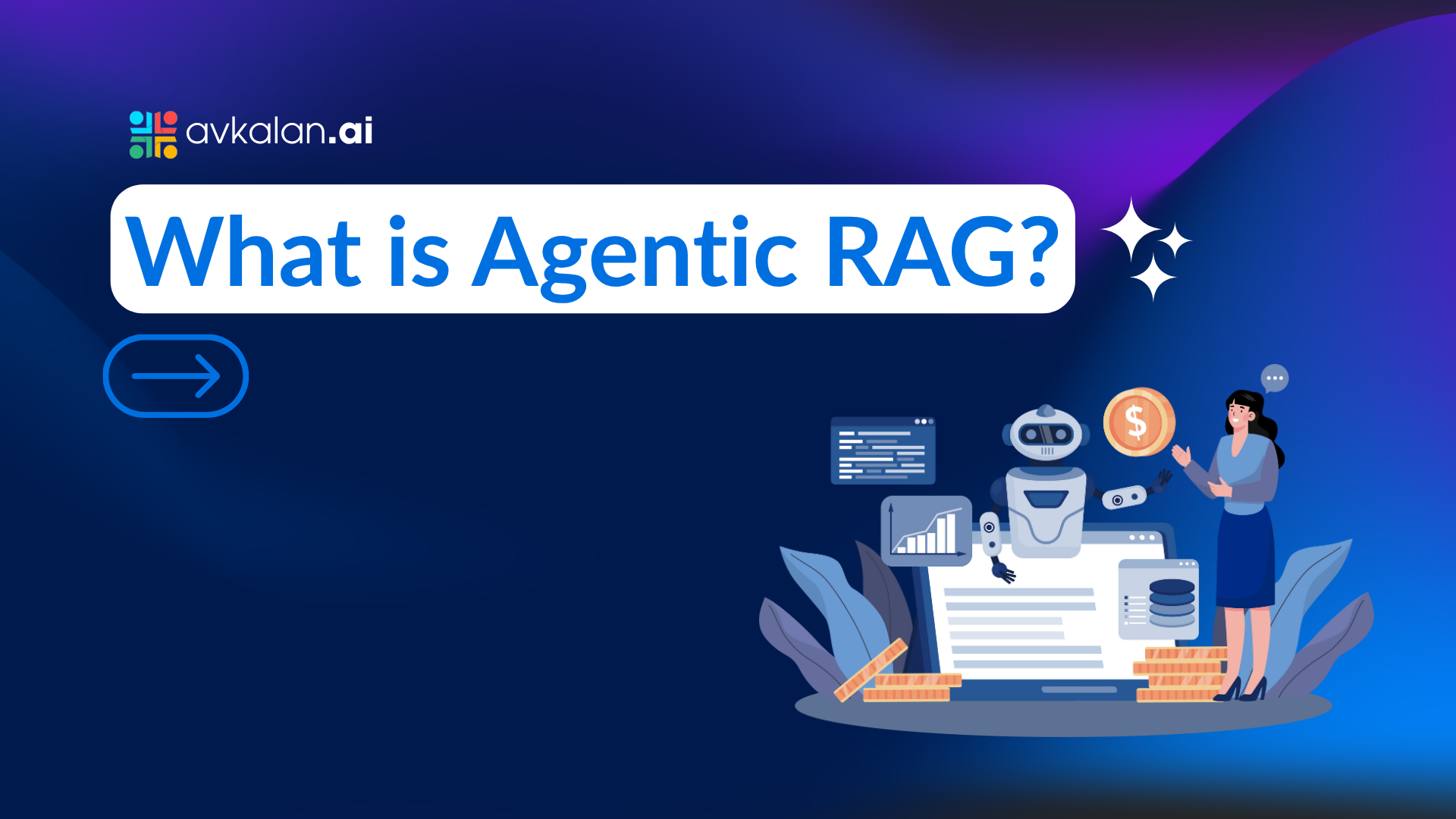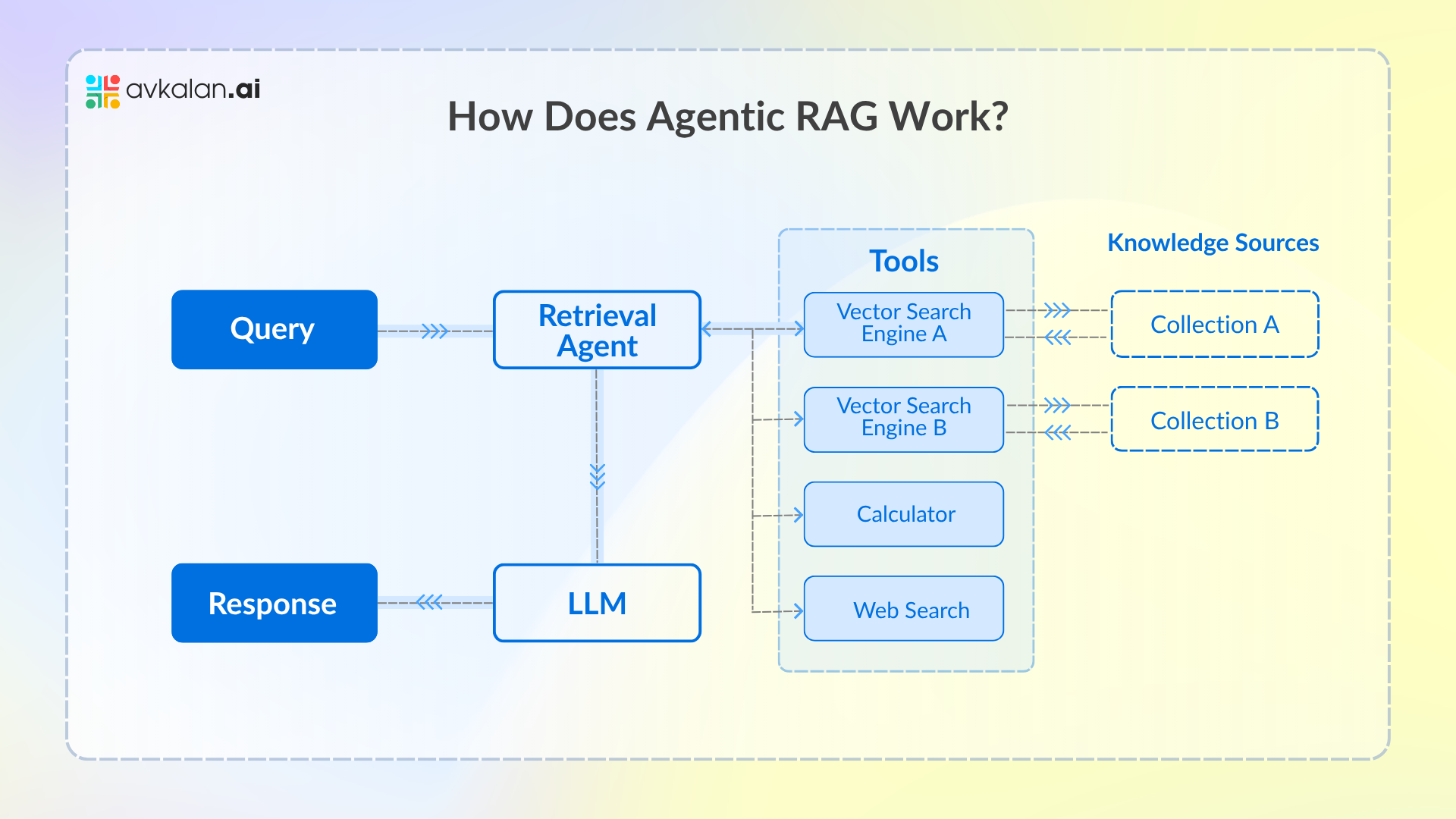
Retrieval Augmented Generation (RAG) had made it big in 2023. While, Agentic Workflows have started experiencing significant growth in 2024. AI agent implementation creates possibilities to build more versatile and robust Large Language Model (LLM) – activated apps. One of such good possibilities is to boost RAG pipelines with AI agent implementation in Agentic RAG sources. Do you want to learn in detail about Agentic RAG? This post outlines what is Agentic RAG, how it works, its architecture, its benefits and all other relevant important concepts that you should know. Keep reading.
What is Agentic RAG?
Agentic RAG is RAG’s AI agent-centric implementation. It integrates AI agents to the RAG pipeline to arrange its elements and perform extra activities beyond simply retrieving and generating information to compensate for the restrictions of non-agentic routes. Agentic RAG is basically RAG’s AI agent-activated implementation.
How Does Agentic RAG Work?

Agentic RAG is usually the implementation of agents in the retrieval elements. You can incorporate agents in various phases of the RAG pipeline. The retrieval element gets Agentic via the implementation of retrieval agents with access to various retrieval tools, such as vector search engine/query engine, web search, calculator, and an API to programmatically access software, like chat or email programs.The RAG agent can perform reasoning to determine if to retrieve additional information and select the right tool for a task. It can formulate the queries, assess the retrieved context and decide if it requires to be retrieved again
Agentic RAG Architecture
Agent is the core of Agentic RAG’s structure, unlike the sequential RAG structure. Agentic RAG frameworks may have different levels of complications. A single-agent RAG structure is a router in the most normal form. You can add many agents to a multi-agent RAG structure.
Here are the two key fundamental RAG structures:
- Single Agent RAG (RAG) : Agentic RAG is simply a router, which means you have a minimum of two external sources of knowledge. The agent decides from which source the extra context is to be retrieved. The external knowledge sources don’t require to be restricted to vector databases. You can retrieve more information from tools. For instance, you can implement an API or do an online search to retrieve extra information from email accounts and Slack channels.
- Multi-Agent RAG Systems : The single-agent system comes with certain limitations since it is restricted to one agent with reasoning, generating replies and information retrieval. So, it is beneficial to use a multi-agent RAG app by chaining multiple agents. For instance, you can have a master agent that coordinates retrieving information among multiple special retrieval agents. A single agent can retrieve information from personal internal data sources. The other agent may be capable of retrieving data from personal accounts such as chat and email. While, another agent may specialize in acquiring public information from online searches.
Agentic RAG vs Vanilla RAG
The core concept of RAG is sending queries, retrieving data and generating responses. The tool utilization generalises it, which makes it more powerful and flexible. Vanilla (common) RAG is like being present at the library to reply to questions before the arrival of smartphones. Whereas, Agentic RAG is like handling a smartphone with your hands via a web browser, emails and calculator.
Agentic RAG Implementation
AI agents have multiple elements. When it comes to building an Agentic RAG channel, you have two options – language models with function calling and agent frameworks. Both these types of implementations deliver the same kind of results depending on your desired flexibility and control. Let’s discuss these two types below.
- Language Models with Function Calling : Language models with function calling are the key element of Agentic RAG systems. Tools are another key element that encourages the language model access to external assistance. With language models, you can build a robust Agentic system by allowing it to interact with presentation tools. The language model providers have included this feature for their clients.
- Agent Frameworks : Agent Frameworks such as Letta, Llama Index, CrewAI, Lang Chain and DSPy help in building apps using language models. Such frameworks make it easy to build Agentic RAG systems by creating pre-made templates at a time.
- Letta interfaces understand and modify an internal model as functionalities. It focuses on search results to upgrade the Chatbot user’s agent memory and reply to the queries.
- Llamando have released the QueryEngineTool, which is a collection of retrieval tool templates.
- CrewAI, one of the top frameworks, helps in building multi-agent systems. Sharing tools among agents is one of the crucial concepts used in tool application.
- LangChain offers numerous services to work with tools. LangChain’s LangGraph and LCEL structures further provide built-in tools.
- DSPy optimizes Avatar and React agents. Avatar optimization explains the utilization of automated prompt engineering to describe every tool.
- Swarm, an OpenAI framework for multi-agent arrangement, focussed on the sharing of tools among agents.
Benefits of Agentic RAG
The evolution from vanila RAG to Agentic RAG helps the systems to deliver more correct replies, independently perform tasks and easily associate with humans. The key benefit of Agentic RAG is mainly the better standards of retrieved extra information. As you include agents giving access to tool utilization, the retrieval agents may route queries to the dedicated source of knowledge. Moreover, the AI agent’s reasoning skills add a level of validation to the retrieved context prior to using it for deeper processing. As a consequence, Agentic RAG routes may deliver more accurate and solid responses.
Why Are Companies Implementing Agentic RAG?
Nowadays, companies are shifting from vanilla RAG to implementing Agentic RAG apps. A high-quality agent can help developers in building and debugging software. Microsoft has recently announced about launching Copilots, which function with users to give suggestions in finishing tasks.
The Bottomline
Agentic RAG is here to stay because of its benefits and growing acceptance among enterprises. Diverse frameworks are advancing to implement Agentic RAG, such as Letta and Llama Index. With the help of dedicated AI services, you can implement this technology in the best ways and grow your business.
